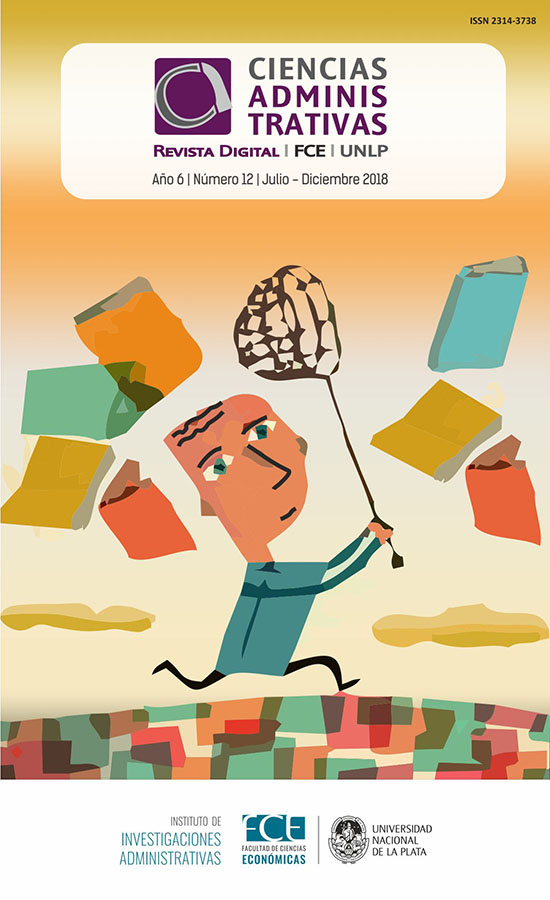Creative accounting in the corporate governance of companies
DOI:
https://doi.org/10.24215/23143738e027Keywords:
Creative accounting, Corporate governance, Strategy and FraudAbstract
This paper aims to analyze the impact of creative accounting on corporate governance of companies through figures manipulation by taking advantage of legal gaps. This Artifice allows building up a matrix of positive opinion in front of its stakeholders and especially, if it has a significant effect, in the value of its actions. The problem lies in the fulfillment of the objectives regardless of the form, using the permissibility, subjectivity and ambiguity in the interpretation of the legal regulations. In this context, the present research seeks to determine the causes and effects of the use of creative accounting in the corporate governance of companies. For this purpose a theoretical description of documentary type will be carried out, it will consist in the search, organization and analysis of several scientific and review articles related to the subject.
Among the conclusions it was determined that creative accounting regardless of the reason it is used; whether by business strategy or to commit fraud it will always provide imperfect information. This situation allows the concealment of facts that deepen the differences of interests between the shareholders and the business managers.
Downloads
Metrics
References
Baracaldo, N. (2013). ¿Es garante del principio de transparencia la implementación de normas internacionales en Colombia? Cuadernos de Contabilidad 14(36), 1097-1120.
Blasco, J. (1998). De la Contabilidad Creativa al delito contable. Partida Doble (85), 33-39.
Rodríguez, M. C. (2001). La contabilidad creativa: análisis de la fiabilidad de la información contable. Pearson Educación
Charreaux, G. (1987). La théorie positive de l´agence: une synthèse de la littérature, en G. Charreaux et al., De nouvelles théories pour gérer I´entreprise, Económica.1987.
Coriat, B. y Weinstein, O. (2011). Nuevas teorías de la empresa. Una revisión crítica. Buenos Aires: Lenguaje claro.
Crespi, R. y Gispert, C. (1999). Implications for the governance of Spanish companies. II foro de finanzas. Segovia.
Gay, J. (1999). El perfil fiscal de la Contabilidad Creativa ¿magia financiera o brujería contable? Partida doble (98), 98-107.
Giner, B. (1992). Un vistazo a la Contabilidad Creativa. Partida Doble (21), 4-12.
Griffiths, I. (1988). Contabilidad Creativa: cómo hacer que los beneficios aparezcan del modo más favorable. Bilbao: Ediciones Deusto.
Guevara, I. y Cosenza, J. (2004). Los auditores independientes y la contabilidad creativa: estudio empírico comparativo. Compendium(12), 5-24.
Guevara, I. y Cosenza, J. (2006). Principales causas que motivan la contabilidad creativa en Venezuela: La gerencia y sus herramientas de manipulación. Compendium, 9(16), 5-31.
Healey, P. y Wahlen, J. (1998). A review of the earnings management literature and its implications for Standard setting. Working paper.
IFAC. (s.f.). International Standards on Auditing, ISA. Obtenido de Norma Internacional de Auditoría NIA-11 Sección 240 Fraude y Error: www.ifac.org
Jameson, M. (1988). A practical guide to creative accounting. London: Kogan Page.
Jensen, M.C. y Meckling, W.H. (1976). Theory of the firm: Managenial behavior, agency cost, and ownership structure. Journal of Financial Economics 3, 305-360.
Laínez, J. y Callao, S. (2000). La contabilidad creativa y su auditoría. Madrid: Instituto de Auditores Censores jurados de cuentas de España.
Monterrey, J. (1997). Entre la Contabilidad Creativa y el delito contable: la visión de la Contabilidad privada. Trabajo presentado en el V Seminario Carlos Cubillo, U. Autónoma de Madrid.
Naser, K. (1993). Creative financial acounting: its nature and use. London: Prentice Hall.
OCDE, O. p. (2004). Principios de Gobierno Corporativo de la OCDE. París: Lerko Print S.A.
Perry, S. y Williams, T. (1994). Earnings management preceding management buyout offers. Journal of Accounting and Economics 18, 157-179.
Salas Fumas, V. (1987). Economía de la Empresa. Barcelona: Ariel.
Smith, T. (1992). Accounting for Growth: Stripping the Camouflage from Company Accounts. Century Business..
Whittington, O. y Panny K. (2003). Auditoría un enfoque integral (12 ed.). Bogotá: Mc Graw Hill.
Downloads
Additional Files
Published
How to Cite
Issue
Section
License
Those authors who have publications with this journal, agree with the following terms:
a. Authors will retain its copyright and will ensure the rights of first publication of its work to the journal, which will be at the same time subject to the Creative Commons Atribución-NoComercial-CompartirIgual 4.0 Internacional (CC BY-NC-SA 4.0) allowing third parties to share the work as long as the author and the first publication on this journal is indicated.
b. Authors may elect other non-exclusive license agreements of the distribution of the published work (for example: locate it on an institutional telematics file or publish it on an monographic volume) as long as the first publication on this journal is indicated,
c. Authors are allowed and suggested to disseminate its work through the internet (for example: in institutional telematics files or in their website) before and during the submission process, which could produce interesting exchanges and increase the references of the published work. (see The effect of open Access)





































